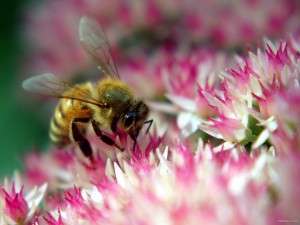Hope for the Honeybees! Can we Help?
Categories: News
 Is there anything we can do to help our plant pollinators? Terry Lieberman-Smith of the Ohio State Beekeepers Association believes there is. While the complete topic is too broad to narrate in-depth here, her article provides a glimpse into some of the issues that affect both pollinators and humans.
Is there anything we can do to help our plant pollinators? Terry Lieberman-Smith of the Ohio State Beekeepers Association believes there is. While the complete topic is too broad to narrate in-depth here, her article provides a glimpse into some of the issues that affect both pollinators and humans.
Dorothy, in the Wizard of Oz, only had to worry about “Lions and Tigers and Bears, Oh My”
…along with the occasional witch and flying monkey. Our industrious pollinators (such as bees and butterflies) have a slightly longer, and quite real, list of life-threatening worries which include pesticides, herbicides, miticides, fungicides, mono-cultural farming, and restrictive zoning. However, these issues also are impacting our life in widespread ways.Honey bees are the silent partner in the agricultural world. Thanks to the efforts of these tiny little insects, and their keepers, we can enjoy abundant, affordable quality food and a bountiful and colorful garden. From large-scale pollinators to the backyard beekeepers, honey bees pollinate within a 3-mile radius of their location, so even the single backyard hive provides “free” pollinating services to neighboring orchards, gardens, CSAs and park facilities.
Honey bees are the most efficient, diverse pollinator in our agricultural system. They pollinate over 130 commercially managed plants. Every dollar a farmer spends on pollination services returns $152 extra in crop yield. The annual value of honey bee pollination to US agriculture is estimated at over $14 billion. The 2013 honey crop was valued at $317.1 million.
Unfortunately, honey bees, like most of our pollinators, are becoming victims of our chemical warfare with nature, reduced acreage of nutritional forage through single-crop farming techniques along with systematic removal of plant diversity, and a lack of tolerance of their presence in our communities.
Monarch butterflies are also suffering the effects of our actions. The Monarch migrates from North America to Mexico each year. We have wiped out enough of their forage to equal the acreage in Indiana (24 million acres). Milkweed, the Monarchs main forage, is considered a weed and is being eradicated in many areas. Monarchs are not healthy enough to take the long journey south to overwinter, and die during our cold winter weather.
The synergistic effect of the wide-spread use of chemicals, and the lack of appropriate nutritional forage, have caused the honeybees to become susceptible to pathogens and pests that they otherwise might have been able to tolerate. Honey bees are like humans, when our bodies are under stress and we don’t have the proper foods, we succumb to colds, flus and aches and pains that we might otherwise be able to stave off easily.
While we can take some warm tea and honey to heal a sore throat, the bees have no such remedy. Like all creatures, they need good food, fresh water, and limited exposure to chemicals in order to stay healthy and to provide us with a delicious array of healthy food in a colorful world.
Become part of the solution and learn how to “Create a Buzz Worthy Garden” at the upcoming (MVG) March 14th presentation…our pollinators are counting on you!




Comments are closed.